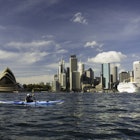
Gaze over an Australian gorge from a skywalk 100 meters above ground

Jul 3, 2020 • 3 min read

© Western Australia Department of Biodiversity, Conservation and Attractions
Thanks to its stunning red sandstone cliffs and gorges, Western Australia’s Kalbarri National Park is one of the Coral Coast region’s biggest attractions, and visitors can now take in the gorgeous views from a whole new perspective – a skywalk perched 100m above ground, on a platform that stretches out into thin air.
- placement: fullWidth
- path: articles/in-content-top
- possible size: [970, 250], [970, 90], [728, 90], [300, 250], [320, 50], [1, 1],
- targeting:
{ "url": "kalbarri-skywalk-western-australia-coral-coast", "destination": "Australia", "continent": "Australia-&-Pacific", "country": "Australia" }
Opened in June, the Kalbarri Skywalk is located at the West Loop lookout, where its two viewing platforms extend 25m and 18m out beyond the rim of the Murchison River Gorge. Its features include wheelchair-accessible viewing structures as well as shade shelters, paths, and more – an inclusive concept designed by architect Craig Poletti of Eastman Poletti Sherwood.

A 6.5-hour drive north of Perth, the national park is set on the traditional lands of the indigenous Nanda people, and the project emphasizes that heritage with a welcome sign in the Nanda language and interpretive Aboriginal artwork along the Skywalk’s paths (think: a sandblasted rendition of the Beemarra serpent, an image central to the dreaming story of the Nanda people, per a press release.)
- placement: fullWidth
- path: articles/in-content-middle
- possible size: [970, 250], [970, 90], [728, 90], [300, 250], [320, 50], [1, 1],
- targeting:
{ "url": "kalbarri-skywalk-western-australia-coral-coast", "destination": "Australia", "continent": "Australia-&-Pacific", "country": "Australia" }
“Three Nanda artists worked on pieces to include around the site,” Rory Chapple, midwest regional operations officer with the Department of Biodiversity, Conservation and Attractions, tells Lonely Planet. “These include tall metal message sticks that create a forest, embellished with traditional drawings; a river design cut into sections of the shelter roofs that project shadows onto the floor and shelter walls; seats carved with bush tucker and native animal designs; and two unique art pieces – ‘the Beemarra’ and ‘Coming Together’ pieces – sandblasted into the pathways.”
Though the project officially began in 2016, things actually got rolling a few years earlier, when Western Australia’s Department of Biodiversity, Conservation and Attractions was looking to shore up vehicle access to the national park. “Back in 2013,” Chapple says, “the park’s gravel road out to the main gorge sites was poor and quite a few accidents had occurred.”

- placement: native
- path: articles/in-content-native
- possible size: [f, l],
- targeting:
{ "url": "kalbarri-skywalk-western-australia-coral-coast", "destination": "Australia", "continent": "Australia-&-Pacific", "country": "Australia" }
The problem was money. Some AUS$10 million was needed to improve the road, and a cantilevered lookout was just the leverage needed to secure a larger redevelopment package. “We had always wanted to develop a lookout at the highest point looking out over the Murchison River Gorge,” Chapple says, and the project would be just what was needed to ensure better roads and other upgrades at other key locations.
Once the necessary funds were received, Poletti worked with Terpkos Engineering to conduct pedestrian-induced vibration analyses and wind-tunnel testing. The structures were built with weathering steel made in South Australia, then fabricated in Perth and transported to the site in six semitrailers. It was a massive undertaking, quite literally.
“Each Skywalk is bolted to a pair of sleeve plates, which weigh 10.4 tonnes and 7.8 tonnes retrospectively,” Chapple says. “The sleeve plates are like giant caps that are attached to concrete footings which sit below ground in excavated slots in the 400-million-year-old sandstone. These concrete footings weigh a total of 225 tonnes and are anchored more than 10m deep into the sandstone so as to act as a cantilever to the weight of the Skywalk hanging out over the cliff.” More than 1000 tonnes of rock were eventually excavated for the footings and given new life as landscaping elements – steps, seats, terracing, walls, and artistic elements, Chapple adds.
For more information, visit australiascoralcoast.com.
You may also like:
Why Tasmania is perfect for ecotourists
The 10 best treks in the world
Sustainable travel: 6 ways to make a positive impact on your next trip
- placement: fullWidth
- path: articles/bottom
- possible size: [970, 250], [970, 90], [728, 90], [300, 250], [320, 50], [1, 1],
- targeting:
{ "url": "kalbarri-skywalk-western-australia-coral-coast", "destination": "Australia", "continent": "Australia-&-Pacific", "country": "Australia" }
Explore related stories









